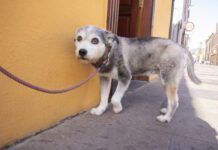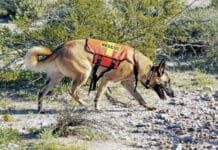NONVERBAL COMMUNICATION OVERVIEW
What you can do…
– Pay attention to your dog’s responses to your movements. Our dogs watch us much more carefully than most of us realize.
– Be consistent with your physical cues. The more consistently you use them, the faster your dog will understand what they mean.
– With a new or young dog, avoid using body language that dogs find threatening, such as hugging or looming over the dog, staring him straight in the eyes, or grabbing his collar at the scruff of his neck.
Week Three of our training class. We are working on “verbal downs” – getting the dogs to lie down on just a verbal cue. Diane and her exceptionally sweet and compliant eight-month-old Great Dane, Gable, aren’t succeeding. I ask her if I can try.
“Sure!” she says cheerfully. A lazy wag of Gable’s long tail signals his willingness as Diane passes me his leash. I wait for Gable to offer a sit, which he does as promptly as his gangly, adolescent body allows.

Arms relaxed by my sides, I say “Down!” in a clear and happy voice. He stares adoringly into my eyes and remains sitting. I wait three seconds, then lure him down with the treat hidden in my right hand. He follows the lure to the floor, I click the clicker in my left hand, and pop the treat in his mouth. We repeat this a couple of more times, with a click! and treat each time.
I ask for the down again, and give an almost imperceptible nod of my head. He drops halfway to the floor and glances up at me, eyes bright. I give him an enthusiastic “Good boy!” and quickly lure him the rest of the way down, then click and treat. On the fifth trial, I give the verbal down cue without moving. He stares into my eyes for a heartbeat, then sinks all the way to the floor. Click! and jackpot (a cascade of treats).
Canine Body Language
Dogs are, first and foremost, body language communicators. While they do have a limited ability to communicate vocally, they are much more articulate with their subtle body movements, and much more intuitively able to understand ours. As Patricia McConnell says in the introduction of her excellent book, The Other End of the Leash, “All dogs are brilliant at perceiving the slightest movement that we make, and they assume that each tiny movement has meaning.”
Watching my students in class, I can see that the ones who tend to be most successful are those who are most consistent with their body movements. Consistency allows the dog to attach a consistent meaning (and response) to the movement. The more inconsistent the movement, the harder it is for the dog to connect the human’s random motions to a specific behavioral response. Gable was able to do a verbal “Down” for me in just five repetitions because:
1. Diane had done three weeks of work with him luring the down (and some work on the verbal cue “Down”), so he was very familiar with the cue and the behavior. I just had to fade the lure.
2. On the first three attempts, I separated the verbal cue from the motion of the lure, so he had the opportunity to process the word separately from the lure.
3. On the fourth repetition I gave the verbal cue, along with a body language cue to help him translate, then gave him a few seconds to process it. His half-down was a question – “Is this right?” My “Good boy!”, lure, click!, and treat constituted a big combined “YES!” answer to his question. Dog owners often miss their dogs’ questions, or fail to answer them.
4. By the fifth iteration, it was clear to Gable that the verbal “Down!” meant the same thing as the lure. The tiny movement of my head served to bridge the gap between the verbal cue and the behavior for him. We had successfully translated the body language into spoken English.
It is because of a dog’s use of body movement as a first language that we can train so successfully using lure-and-reward methods, and easily teach hand signals. However, the importance of understanding and responding appropriately to our dogs’ body language goes far beyond formal training. Body talk can make everyday life with your dog easier, enhance your relationship, and overcome some of the canine behaviors that are giving you grief.
Cross-Species Communication
One of the reasons humans and canines co-exist so beautifully is that we are both social species – we live in groups and create social rankings within those groups. Both species intuitively understand the concept of a “group leader” (Alpha Dog = Head of Household, Employer, President of the US); both species have members in their various groups who lead more naturally than others; and in both groups, ranking (or status) is fluid: You might be the head of your household, but subordinate to your boss at work, or to a colonel in the Army, or the Queen of England. Your dog might be the leader of your dog pack, but have very low status among the regular canine visitors at your local dog park.
However, canine and primate body talk have very different vocabularies, which can cause serious conflict between our species. For example:
– Humans meet face-to-face and hug. Dogs tend to meet obliquely, and a dog who puts his chin or paws over another’s shoulders in greeting is probably making an assertive statement about his rank – which may well elicit an aggressive response. This is why dogs have a tendency to bite when kids (or adults) hug them.
It is considered polite by humans in the Western world to make direct eye contact. Failure to do so is considered evidence of lack of character – disrespectful, shifty, or outright untruthfulness. (This is not true in some other human cultures, where direct eye contact is considered rude.)
– In the canine dictionary, direct eye contact is an assertion or a threat. The dog on the receiving end either looks away, a sign of submission – in order to avoid a fight – or takes offense and engages in agonistic (aggressive) behavior in response. The other dog backs off, or a fight occurs. This is one reason why so many children are bitten. They tend to stare at dogs anyway, and the more strangely (aggressively) the dog behaves, the more a child stares. Adults who insist on direct eye contact with strange dogs also tend to get bitten.
– We naturally face another person that we are speaking to, and our force-based culture encourages us to get more strident if a subordinate fails to comply with our requests. We were once taught to call our dogs by standing squarely facing them, arms at our sides, and saying “Come!” in a commanding tone of voice. Our voices got louder, more insistent, perhaps even angry, if our dogs failed to come.
Dogs see a full-frontal communication as a threat, and loud, firm, angry vocalizations as aggressive. Their natural response is to turn away in appeasement, or at best, to approach slowly, in a submissive curve, rather than the speedy, enthusiastic straight line that we strive for.
– We often reach for our dogs’ collars over the top of their heads. They see this as a direct threat; they duck away in submission (or they bite), and learn to avoid us when we are trying to catch them. We follow or chase them, intimidating them further or, alternatively, teaching them that if they take the lead, we follow. The more we try to catch them, the more they avoid us.
– We bend over them to pet them on the top of their heads, or to cuddle them. Again, we are unwittingly offering a posture of threat and intimidation. Primate “hovering” is a very off-putting posture for dogs. Dogs back away in fear or submission, or worse, bite in an aggressive response.
Prompted by ill-advised old-fashioned thinking, some people still use force (such as alpha rolls and scruff shakes) to overpower and dominate their dogs. Most dog body language is very subtle and in large part ritualistic, including the “belly-up” position, which is usually offered voluntarily by the subordinate pack member, not forced by the higher ranking one. Dogs experience the alpha roll as a violent, terrifying attack, and some will respond out of a likely belief that they are fighting for their very lives.
Doggy Adaptability
If you think about it, it’s surprising that we get along with our dogs as well as we do! The good news is that both of our species are pretty darned adaptable. We can teach our dogs to appreciate some of our bizarre primate behaviors, and we can learn to use canine body talk to our advantage.
We humans pretty much insist on hugging our dogs. Touch is so important to us that as much as we may intellectually understand our dogs’ resistance to such close body contact, our hearts overpower our heads and we just have to hug them.
When a dog reacts badly to being hugged, it’s often an innate response, not a conscious decision. The dog doesn’t sit next to the hugger, ponder his options, and make a deliberate decision to bite. Rather, the hug triggers a subconscious response: “Threat! Fight or flee! If the dog can’t flee – because he is being hugged – or is one of those dogs whose fight response is stronger than his flight response, he bites.
It’s easiest to teach a dog to accept hugging if you start associating gentle restraint with something yummy when he is very young. Using counter-conditioning and desensitization to change his natural association with close contact from bad (Danger! Run away!) to good (Oh yay! Cheese!), you can convince the part of his brain that reacts subconsciously, that being hugged is a very good thing.
To do this, hold the dog at a level of restraint with which he is very comfortable – perhaps just a light touch of your hand on his back. Feed him a tiny tidbit of something wonderful, and remove your hand. Repeat this step until he turns his head eagerly toward you in anticipation of his tidbit when he feels your hand touch his back.
Now, very slightly increase the intensity of your touch, by holding your hand on his back longer and feeding him several treats in a row; by pressing a tiny bit harder on his back; or by moving your arm a little farther over his back, so your hand brushes his ribs on the other side. The more your dog accepts touch, the more quickly you will be able to move through the counter-conditioning and desensitization process.
Note: Increase the intensity of only one stimulus at a time. For example, work on length of time until he is perfectly comfortable with long “hand-rests,” then shorten the time while you work on increased pressure. When he is comfortable with each new stimulus, add them together. When he can handle more pressure happily, start using more pressure for longer periods. Then ease up on both of these while you work on moving more of your arm over his back.
Of course, it is vitally important to teach children (and uninitiated adults) not to hug dogs unless they know the dog very well and are totally confident that the dog is fully comfortable with such intimate contact. Even then, young children should never be left unattended with any dog.
The same approach used to teach your dog to appreciate a hug works with many “culture clash” behaviors. If you want your dog to love having his collar grabbed, pair the action with cheese, or hot dog, or chicken. This particular exercise should be taught to every dog. Perhaps you know that the safest way to take hold of a dog’s collar is gently, under the chin. But if a friend tries to grab the collar over your dog’s head, it would be nice if she doesn’t get bitten for her primate behavior, because your dog has learned to accept it.
You can also teach your dog that eye contact is a good thing, by encouraging him to look into your eyes, and rewarding him when he does. (The clicker is very useful here.) Have your dog practice this with other people as well, if you want him to be comfortable with that pervasive and offensive primate penchant for staring rudely into canine eyes. And, again, teach your children not to stare into a dog’s eyes.
Human-Dog Communication is a Two-Way Street
While you are teaching your dog to understand and accept primate language, you can also learn and use canine body language. This will greatly enhance your relationship and your training program, since your dog can respond very quickly when he realizes you are speaking Dog.
McConnell describes a process that she calls “body blocking,” which simply means taking up the space to prevent your dog from doing so. Let’s say your dog is on a Sit/Stay while you are cooking in the kitchen, and you drop a fried drumstick on the floor. Tess starts to get up to get it. Rather than grabbing at her or yelling “STAY!” simply step forward into the space she was about to occupy. Like magic, she settles back into her Sit/Stay. McConnell reminds us that the sooner you react the better, and says that once you get good at it, you can simply lean forward an inch or two to express your intent to occupy the space.
You can also use body blocking with dogs who jump on you. Next time you are sitting in a chair and your wild Westie makes a running charge for your lap, clasp your hands against your stomach and lean slightly forward, blocking the space with your shoulder or elbow. It also helps to look away, rather than make eye contact. You may have to do several repetitions of this, especially if your dog has had much practice lap leaping, but it can be very effective if you are consistent. He can learn to wait for permission to jump up – on your lap, or on the sofa next to you.
I used body blocking for years without thinking about it or defining it as clearly as McConnell does. When our four dogs are all doing “Wait” at the door, I can release them one by one, by name, in part because I use subtle body blocking movements to indicate which dogs are to remain in place. As with the “Stay” blocking, the more you do it, the more subtle the movements can become, because dogs are so good at reading tiny body language signals.
This is just one example of the many ways you can make the canine/primate difference work for you as you build a relationship with your dog based on mutual trust and respect, and as you encounter other dogs. Move (run!) away from your dog when you want her to come, rather than moving toward her. She will follow the leader, instead of moving away from an intimidating direct approach. Look away from the challenging stare of an aggressive dog, instead of returning the eye-contact challenge, and you are more likely to escape from the experience bite-free.
We, as the supposedly more intelligent species, should be able to understand and forgive canine behaviors that clash with our human social expectations. It seems that our dogs are pretty darned good at understanding and forgiving ours, thank goodness. As you and your dog journey together through life, each translating primate to canine and vice versa, appreciate the great value of this cultural diversity.
Pat Miller, WDJ’s Training Editor, is also a freelance author and Certified Pet Dog Trainer in Chattanooga, Tennessee. She is the president of the Board of Directors of the Association of Pet Dog Trainers, and published her first book, The Power of Positive Dog Training, in 2001.





